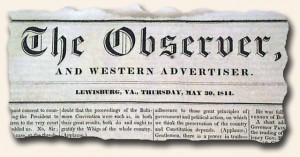West Virginia’s first newspapers…
January 28, 2013 by TimHughes · Leave a Comment
 The history of West Virginia newspapers dates some 70 years before West Virginia became a state. Statehood came late to West Virginia, carved from Virginia in the midst of the Civil War, happening officially on June 20, 1863. But its first newspaper began in 1790 when Nathaniel Willis began his “Potowmac Guardian & Berkeley Advertiser” at Shepherd’s-Town, near Harper’s Ferry. Less than two years later Willis moved the newspaper to Martinsburg.
The history of West Virginia newspapers dates some 70 years before West Virginia became a state. Statehood came late to West Virginia, carved from Virginia in the midst of the Civil War, happening officially on June 20, 1863. But its first newspaper began in 1790 when Nathaniel Willis began his “Potowmac Guardian & Berkeley Advertiser” at Shepherd’s-Town, near Harper’s Ferry. Less than two years later Willis moved the newspaper to Martinsburg.
The second newspaper was the “Shepherd’s Town, Charles-Town and County Advertiser” begun by Philip Rootes and Charles Blagrove on June 28, 1797. No copies beyond October 11, 1797 have been located. The third newspaper was the “Berkeley Intelligencer” done at Martinsburg on April 3, 1799 by John Alburtis. Many followed, including what is shown in the image, “The Observer, and Western Advertiser”, Lewisburg, [West] Virgina, 1884.
The Hatfields & McCoys… on Pinterest…
September 3, 2012 by GuyHeilenman · Leave a Comment
 There are few conflicts which have been romanticized as much as the quarter-century battle between two extended families from the boarder mountains of West Virginia and Kentucky. Wikipedia describes the ongoing struggle as follows:
There are few conflicts which have been romanticized as much as the quarter-century battle between two extended families from the boarder mountains of West Virginia and Kentucky. Wikipedia describes the ongoing struggle as follows:
The Hatfield–McCoy feud (1863–91) involved two families of the West Virginia–Kentucky area along the Tug Fork, off the Big Sandy River. The Hatfields of West Virginia were led by William Anderson “Devil Anse” Hatfield while the McCoys of Kentucky were under the leadership of Randolph “Ole Ran’l” McCoy. Those involved in the feud were descended from Ephraim Hatfield (born c. 1765) and William McCoy (born c. 1750). The feud has entered the American folklore lexicon as a metaphor for any bitterly feuding rival parties. More than a century later, the story of the feud has become a modern symbol of the perils of family honor, justice, and vengeance… (view more via Wikipedia)
At Timothy Hughes Rare & Early Newspapers we’ve created a Pinterest Board so that those interested in seeing how these events were reported in the newspapers of the day can enjoy contemporary reports. As we often say, “History is never more fascinating than when it is read from the day it was first reported”.
Please enjoy: Hatfields & McCoys – The Famous Feud… on Pinterest
Hatfields & McCoys…The media drives interest in historical newspapers…
June 14, 2012 by TimHughes · Leave a Comment
There is no question that media events affect our hobby. Although there was always collector interest in the sinking of the Titanic, it wasn’t until the James Cameron movie was released in 1997 that interest exploded. It was amazing to experience the dramatic increase in calls & requests at our office concerning newspapers reporting the Titanic disaster . The movie release preceded the eBay craze so it was only by individual quotes & listings in our catalog that we could keep up with the demand. Prices did increase dramatically.
The “Amistad” slave ship movie had a similar reaction. Few people even knew of the event before the Stephen Spielberg movie, but upon its release we sold dozens of notable issues of the event & subsequent trial at prices which far exceeded those possible before the movie.
 Other historically-themed events in American or world history, whether they happened on the big screen or television, have had similar effect on the rare newspaper hobby. The most recent “event” is the Hatfield-McCoy feud, spurred on by the recent History Channel mini-series.
Other historically-themed events in American or world history, whether they happened on the big screen or television, have had similar effect on the rare newspaper hobby. The most recent “event” is the Hatfield-McCoy feud, spurred on by the recent History Channel mini-series.
Thought by some to be nothing more then legend and not an historical event, the Hatfield McCoy feud was, indeed, very real. We find it interesting the degree to which coverage of the feud appeared in newspapers of the era. We are fortunate to have newspapers from West Virginia (example) in 1889 (the feud happened at the Kentucky-West Virginia border) which have extensive articles on the feud, and our listings on eBay have created a following which far exceeds those listed prior to the mini-series. And many of those following our offerings–and buying them–are new hobbyists who likely never purchased an historical newspaper before.
All this is of benefit to the hobby. Although much criticism has been levied against what is seen on television and in movie theaters today, occasionally quality productions which are based on historical fact have increased interest not only in America history but also appreciation for genuine newspapers which report those events at the time they happened. This can only be good for the hobby.


